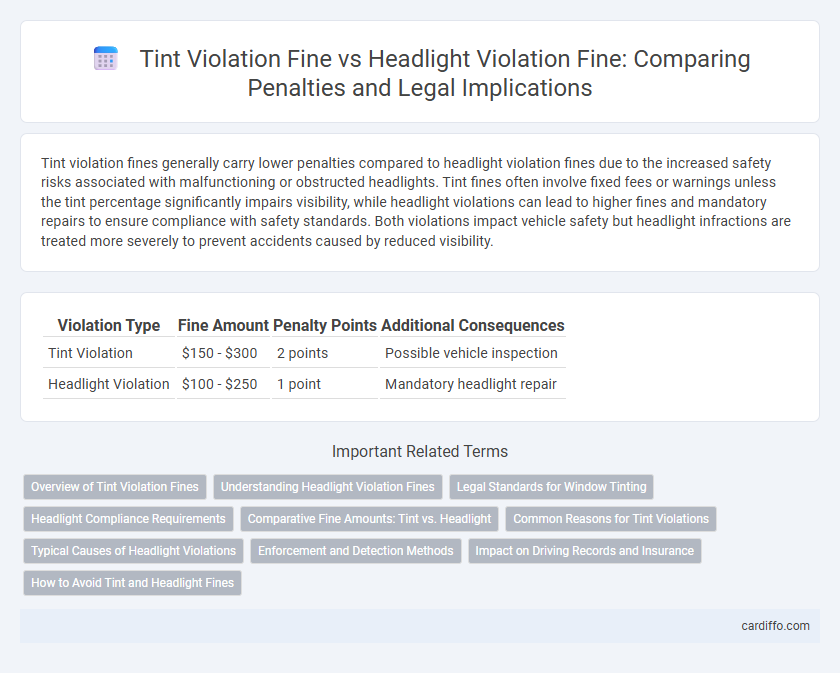Tint violation fines generally carry lower penalties compared to headlight violation fines due to the increased safety risks associated with malfunctioning or obstructed headlights. Tint fines often involve fixed fees or warnings unless the tint percentage significantly impairs visibility, while headlight violations can lead to higher fines and mandatory repairs to ensure compliance with safety standards. Both violations impact vehicle safety but headlight infractions are treated more severely to prevent accidents caused by reduced visibility.
Table of Comparison
| Violation Type | Fine Amount | Penalty Points | Additional Consequences |
|---|---|---|---|
| Tint Violation | $150 - $300 | 2 points | Possible vehicle inspection |
| Headlight Violation | $100 - $250 | 1 point | Mandatory headlight repair |
Overview of Tint Violation Fines
Tint violation fines typically range from $100 to $500, depending on state regulations and the degree of tint darkness beyond legal limits. These fines often increase with repeat offenses, sometimes leading to additional penalties such as mandatory removal of the tint or vehicle inspection. Unlike headlight violation fines, which generally focus on equipment functionality and can be lower, tint violation fines specifically address visibility and safety concerns related to window tinting.
Understanding Headlight Violation Fines
Headlight violation fines typically incur higher penalties than tint violation fines due to the critical safety risks associated with improper or non-functioning headlights during nighttime or low-visibility conditions. Unlike tint violations, which often vary by the percentage of light allowed through vehicle windows, headlight violations focus on issues such as burned-out bulbs, non-compliant brightness, or incorrect color, directly impacting road safety. Understanding local regulations on headlight standards and associated fines helps drivers avoid costly penalties and ensures safer driving conditions.
Legal Standards for Window Tinting
Legal standards for window tinting vary by state, typically regulating the Visible Light Transmission (VLT) percentage to ensure driver visibility and law enforcement safety. Tint violation fines often result from exceeding the maximum allowable darkness or reflectivity, whereas headlight violation fines stem from using non-compliant or improperly aimed lights. Compliance with these regulations helps avoid penalties and ensures vehicle safety on the road.
Headlight Compliance Requirements
Headlight violation fines typically result from non-compliance with regulations requiring headlights to be functional, properly aimed, and used during designated times, ensuring visibility and safety on the road. These requirements often include the use of headlights from sunset to sunrise and in poor weather conditions, reducing accident risks caused by inadequate lighting. In contrast, tint violation fines focus on window darkness levels that impede visibility for law enforcement, whereas headlight compliance directly impacts driver and pedestrian safety through adequate illumination.
Comparative Fine Amounts: Tint vs. Headlight
Tint violation fines typically range from $100 to $200, reflecting stricter regulations on window opacity to enhance safety. Headlight violation fines, often between $50 and $150, vary depending on the severity of malfunction or non-compliance with lighting standards. Comparing the two, tint violation fines tend to be higher due to potential visibility hazards, whereas headlight fines, while significant, generally carry slightly lower penalties.
Common Reasons for Tint Violations
Common reasons for tint violation fines include windows that are too dark, exceeding the allowable Visible Light Transmission (VLT) percentage set by state laws. Non-compliance often occurs on front side windows and windshield, where regulations are typically stricter to ensure driver visibility and safety. Improperly installed or aftermarket films that do not meet legal standards frequently trigger these fines.
Typical Causes of Headlight Violations
Headlight violation fines commonly result from failures such as using high beams improperly, driving without headlights during required hours, or operating vehicles with burnt-out or broken bulbs. Another frequent cause includes misaligned headlights that impair visibility for other drivers. These issues compromise road safety and attract stricter penalties compared to tint violations.
Enforcement and Detection Methods
Law enforcement uses specialized devices like tint meters to measure window tint darkness for tint violation fines, ensuring compliance with legal limits on light transmission. Headlight violation fines are frequently enforced through visual inspections and nighttime patrols, supported by automatic license plate readers and dashcam footage to detect malfunctioning or improperly aimed headlights. Both violations rely on consistent roadside checks and technological tools to improve accuracy and enforcement efficiency.
Impact on Driving Records and Insurance
Tint violation fines typically result in minor points on driving records, causing limited impact on insurance premiums. Headlight violation fines often carry more severe penalties, potentially adding significant points and leading to higher insurance rates. Insurance companies view headlight violations as greater safety risks, making policyholders more likely to face premium increases.
How to Avoid Tint and Headlight Fines
To avoid tint violation fines, ensure your vehicle's window tint complies with state regulations by checking the allowable Visible Light Transmission (VLT) percentage and using professional installation. Prevent headlight violation fines by regularly inspecting your headlights for proper alignment, brightness, and color temperature that meet Department of Transportation (DOT) standards. Maintaining clear, unobstructed lenses and replacing bulbs before they dim significantly also reduces the risk of headlight violations.
Tint Violation Fine vs Headlight Violation Fine Infographic

 cardiffo.com
cardiffo.com